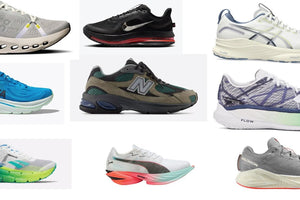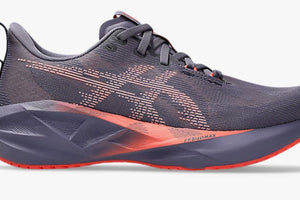2026 Running Shoe Preview: The New Tech That Will Make You Faster
If there is one thing we love more than crushing a PB, it's the gear that helps us do it. As we lace up for the winter grind and look ahead to the spring marathon season, the landscape of running footwear is shifting beneath our feet-literally.
We have been digging through the release schedules, the tech sheets, and the industry whispers for Q4 2025 and Q1 2026. The verdict? The days of "boring" training miles are officially over. We are entering a golden era of footwear where the technology that was once fenced off for elite Olympians is finally trickling down to the rest of us.
Whether you are training for your first 5k or chasing a Boston Qualifier, the next few months are bringing a massive shake-up to your shoe rack. From "illegal" stack heights to foams that feel like rocket fuel, here is your exclusive preview of the shoes that will define 2026.
The Vibe Shift: Goodbye "Super Shoes," Hello "Super Trainers"
For the last few years, runners have had a strict rotation: a heavy, durable, slightly dull shoe for daily plodding, and a fragile, expensive, carbon-plated rocket ship for race day. But as we head into 2026, that line is blurring.
The biggest trend we are seeing is the democratisation of elite materials. Brands are realising that we don't just want energy return on race day; we want it on Tuesday morning recovery runs, too. We are seeing the rise of the Super Trainer-shoes that ditch the aggressive carbon plates (and the stiff, harsh ride) but keep the magical super-foams.

1. Adidas Adizero Evo SL: The Game Changer
Releasing: November 2025
If you have been drooling over the podium-dominating Adidas Adios Pro 3 but can't justify the price or the instability for daily miles, your prayers have been answered. Adidas is dropping the Adizero Evo SL, and it is set to be a massive disruptor.
They have taken Lightstrike Pro foam-the premium, bouncy stuff found in their world-record breakers-and put it into a daily training chassis without the stiff carbon rods. The result? A shoe that feels fast and lively but doesn't beat up your calves. With a 39mm stack in the heel and a 6mm drop, it encourages a smooth midfoot strike. It is designed to be a direct rival to the ASICS Superblast, bringing elite bounce to your everyday jogging loops.

2. New Balance 1080v15: The Material Science Revolution
Releasing: 15 January 2026
Mark your calendars, because the king of cushioning is getting a complete chemical overhaul. For years, the New Balance 1080 has been the "comfort cruiser" standard, built on standard EVA foam. But for the v15, New Balance is retiring the old recipe.
Enter "Infinion." This is a brand-new supercritical foam compound that replaces the old Fresh Foam formula. What does "supercritical" mean? In plain English, it means the foam is injected with gas (usually nitrogen) during moulding to create a lighter, springier, and more resilient cushion.
The v15 pushes the limits with a 40mm heel stack (right on the legal limit for racing, though this is a trainer). This is a massive move from New Balance; they are proving that a "max cushion" shoe doesn't have to feel like a heavy brick. It's softer, lighter, and significantly more responsive than the v13 or v14.
 Waiting for press photos
Waiting for press photos3. ASICS Novablast 6: The Trampoline King
Releasing: December 2025
ASICS has been on a winning streak lately, largely thanks to the Novablast series. If you love that "trampoline" feeling-where the shoe seems to bounce you into the next step-the Novablast 6 is going to be on your Christmas list.
Landing just in time for the holidays, the version 6 is expected to refine the geometry that made it famous. It will likely feature "FF Blast Max," a tuned-up version of their energetic foam that balances durability with that signature pop. Alongside this, keep an eye out for the Megablast, a premium, higher-stacked sibling designed for runners who want to go faster than a Novablast allows, but with more protection than a stripped-down racer.
The Race Day Split: Compliant vs. The "Rule Breakers"
Here is where things get really interesting. The World Athletics body sets strict rules for elite competition shoes: the foam stack cannot be higher than 40mm, and you can only have one rigid plate.
Most brands play by the rules. But some are realising that 99% of us aren't elite athletes. We aren't vying for a podium spot at the Olympics; we just want to run a personal best without destroying our legs. Consequently, the market is splitting into two camps: the Legal Elites and the Illegal Monsters.
The Legal Elites (For the purists)

Nike Alphafly 4 (January 2026) The icon returns. The Alphafly is the shoe that changed the marathon forever, and the version 4 is coming to reclaim the throne. Confirmed for January, this shoe has been developed under the code name "Nike-Dev 16141." Expect a reworked Air Unit integration and a lighter build. It will launch alongside the "Ekiden" collection-a bright, culturally significant colourway series celebrating the Japanese relay season. If you want the absolute pinnacle of legal speed, this is likely it.

Adidas Adios Pro 4 (January 2026) Going head-to-head with Nike, Adidas is refining their marathon racer. The EnergyRods 2.0 system will be tweaked to match the energy return of the Alphafly while offering a slightly more stable ride. If you find the Alphafly too aggressive or wobbly, the Adios Pro 4 is usually the smoother alternative.
The Rule Breakers (For the fun of it)

Puma Fast-RB Nitro Elite (November 2025) Puma has looked at the rulebook and thrown it in the bin. The "RB" stands for Rule Breaker, and they aren't kidding. This shoe features a ludicrous 58mm heel stack height. That is nearly 2cm taller than what is allowed in elite racing.
Why do this? Because a 58mm stack of Nitro Elite foam combined with three carbon plates offers a level of leg-saving cushioning and mechanical propulsion that legal shoes simply cannot match. It is designed for the "marathon tourist" or the amateur who wants to finish a marathon feeling fresh. It is effectively a "Concept Car" for your feet-expensive (around $350/£275), outrageous, and totally banned for pros. But for you? It's fair game.
Brand Watch: Who is doing what?
Beyond the headline grabbers, the rest of the market is making strategic moves to cover every type of runner.
Hoka: Defending the Crown
Hoka invented the maximalist trend, but now everyone else is doing it too. To fight back, they are launching the Mach 7 in December. Historically a low-profile tempo shoe, the Mach 7 is growing up-literally. It's getting taller (36.8mm) and gaining a supercritical midsole. It's Hoka's answer to the Novablast: light, fast, but cushioned enough for daily use.
Brooks: Making Stability Sexy
Stability shoes (for those who overpronate) have historically been heavy and firm. Brooks is fixing that with the Adrenaline GTS 25 (November 2025). They are finally putting their nitrogen-infused DNA Loft v3 foam into their best-selling stability shoe. This means you get the support of the GuideRails system but the bouncy, fun feel of a neutral shoe.
Under Armour: The Biomechanical Niche
While everyone else is building tall, high-drop shoes, Under Armour is targeting the technician. The Velociti Elite 3 (January 2026) features a radical 2mm drop. Most shoes sit between 8mm and 10mm. A 2mm drop is aggressive and flat, designed for runners with a very efficient midfoot or forefoot strike. It's a bold move, positioning UA as the brand for the biomechanically disciplined runner.
Salomon & The Winter Warriors
Running doesn't stop when the snow falls. The Salomon Genesis 2 and New Balance Supercomp Trail 2 are dropping in late 2025. The Genesis 2 is particularly exciting for UK runners-it features a Matryx upper (super tough) and is designed to handle the worst winter mud and slush.
The Tech Breakdown: Stacks, Drops, and Foams
If you are feeling overwhelmed by the jargon, here is a quick cheat sheet on how these changes affect you.
-
Supercritical Foam (PEBA/Nitrogen-Infused): The old white foam (EVA) in your trainers died after 300 miles and felt flat. The new stuff lasts longer and bounces back. In 2026, if your shoe costs over £120, it should have this foam.
-
Stack Height: This is how much foam is under your foot.
-
30mm: Old school standard.
-
40mm: The current "max" standard.
-
50mm+: The new "Illegal" super-cushion standard (like the Puma Fast-RB).
-
-
Drop: The difference in height between your heel and toes.
-
8mm-10mm (Nike/Brooks): Good for heel strikers, easier on the calves.
-
2mm-6mm (Hoka/UA/Adidas): Better for midfoot strikers, but works your Achilles and calves harder.
-
The Sundried Roundup
We know that's a lot of data to digest. To help you make the right choice for your training block, here is our quick-fire guide to the 2026 landscape.
What are the pros wearing?
If they are sponsored by the Swoosh, they will be in the Nike Alphafly 4 come January. If they are with the Three Stripes, it's the Adidas Adios Pro 4. These remain the gold standards for breaking records within the rules. However, we are seeing more pros training in non-plated "super trainers" like the Adidas Evo SL to save their legs during the week.
What's the budget I need to invest?
We have to be honest: the price floor is rising. With "super foams" becoming the standard, the days of a high-performance £100 shoe are fading.
-
Budget Performance: £90 - £110 (e.g., Nike Winflo 12, Brooks Launch 12). Great for beginners, but uses older tech.
-
The New Standard: £130 - £150 (e.g., Adidas Evo SL, New Balance 1080v15). This is where the biggest innovation is happening.
-
Race Day Luxury: £220 - £275+ (e.g., Alphafly 4, Puma Fast-RB).
New In: Running Shoes
What's Best For Me?What's actually the best option for me...
To Run Faster? For race day, stick to the carbon-plated giants like the Alphafly 4. But for training faster? Look at the Adidas Evo SL or the Hoka Mach 7. They give you the energy return to hit your tempo paces without the harshness of a rigid carbon plate.
For Maximum Comfort? It's a tie between the New Balance 1080v15 (with that new Infinion foam) and the ASICS Nimbus 28. If you want to feel like you are running on clouds and don't care about ground feel, these are your winners.
To Last a Long Time? Durability is the new battleground. The Brooks Adrenaline GTS 25 is built like a tank. Alternatively, the Puma Deviate Nitro 4 has incredible outsole grip (Pumagrip) that tends to outlast almost anything else on the road.
For a Front Foot Runner? You need a lower drop to avoid that high heel getting in your way. The Under Armour Velociti Elite 3 is aggressive with a 2mm drop. For daily training, the Hoka Mach 7 (approx. 5mm drop) is a safe bet.
For a Heel Striker? You are the majority! You need protection in the heel and a higher drop to help roll you forward. The Brooks Adrenaline GTS 25 (12mm drop) or the Puma Fast-RB (12mm drop) are engineered specifically to cushion that initial impact and transition you smoothly.
Does spending more make me faster? Yes and no. A £250 super shoe will improve your running economy (energy efficiency) by roughly 2-4% compared to a standard trainer. Over a marathon, that is minutes off your time. However, if you don't have the fitness foundation, a super shoe won't save you. Think of it like putting Formula 1 tyres on a family saloon car-it helps, but the engine matters most!
Ready to upgrade your rotation? Keep an eye on the shop for the latest drops as we head into the new year!







